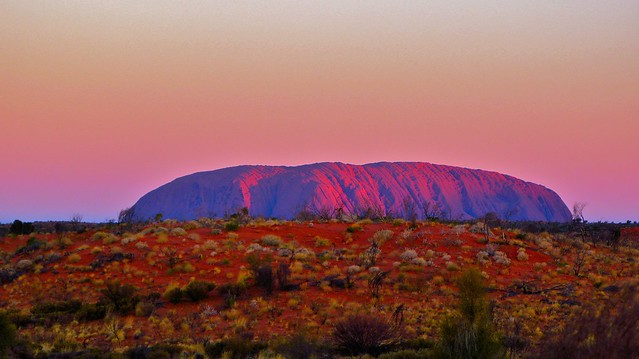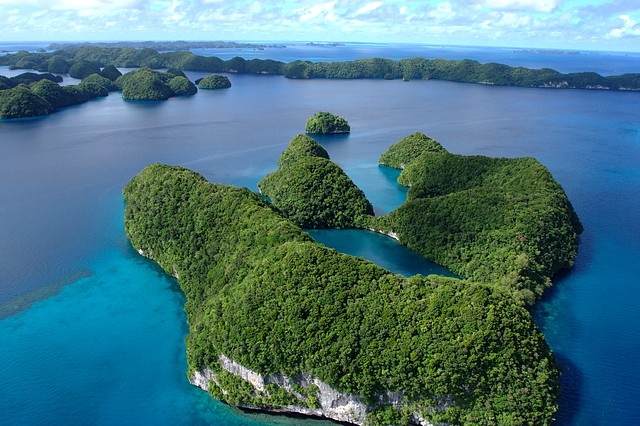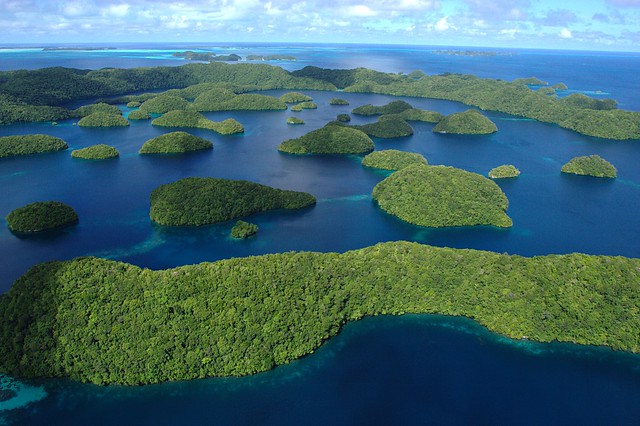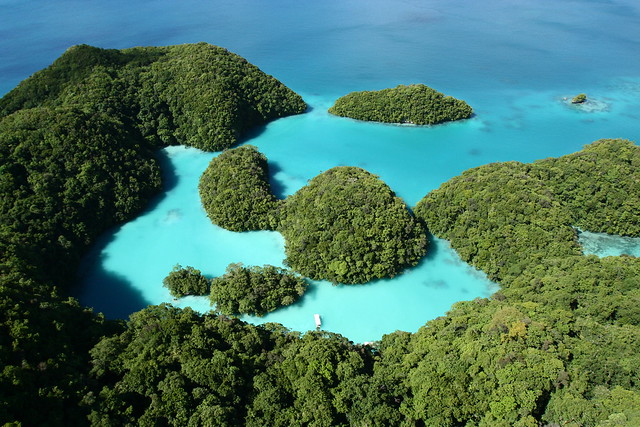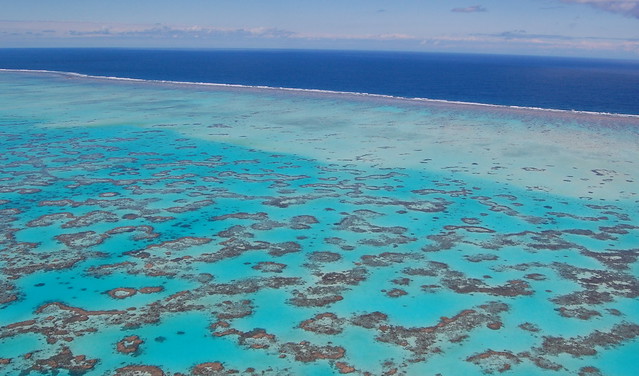What if we try to mix it up? This will be our time to disconnect from all our daily tasks and to know something more about what is out there, that is, beyond what we are able to see.
We are going to put an order, we are going to visit each continent and from each continent we will see the most extraordinary places that they have.
Let's start with the smallest continent on the planet, Oceania.
Land stretching from the continental shelf of Australia to the islands of New Guinea, New Zealand and the coral and volcanic archipelagos of Melanesia, Micronesia and Polynesia, integrating the drier, flatter continent and home to the oldest lands in our world. A continent that presents large desert regions, with 40% of its territory covered by sand dunes, which does not prevent it from harboring some of the world's most exuberant jungles, as well as an abundance of marine ecosystems and extraordinary species that have evolved isolated in his exile. A continent whose name comes from the greek "okeanos". A term that in classic antiquity referred to the vast sea that surrounded the world. A name that seems appropriate for these lands that for so long remained isolated by the waters.
The ten most beautiful natural countries in Oceania.
➤1. Fiordland: The fjords of New Zealand.
The fourteen fjords of the Fiordland National Park form an imposing landscape, where the sea looms between the lofty mountains through the kilometer-long channels eroded by glaciers, running between prominent rock walls from which waterfalls drift from accumulated snow and of old ice sheets. An extraordinary environment, considered by many as the most beautiful national park in the world. A place where dolphins, seals, penguins, keas or the kakapo, the only non-flying parrot on the planet.
➤2.Fraser: The largest sand island on the planet.
The Aborigines knew the island of Fraser by the name of K'gari, which could be translated as "paradise", because it is the word that comes to mind when we contemplate the white sand beaches full of green vegetation, overlooking the ocean Pacific and the migratory routes of whales and dolphins, as well as the innumerable lakes of pristine waters and sandy bottom, surrounded by dunes, reeds and tropical forest, forming an authentic Eden germinated on the sand. Fraser Island is located off the south coast of Queensland, separated from Australia by the Great Sandy Strait. Known for being the largest sand island on the planet, with its hundred and twenty kilometers in length and twenty-four in width.
➤3.The Archaic Forest of Daintree.
The Daintree Rainforest is located on the northeast coast of Queensland, Australia, integrating the largest continuous area of jungle on the oceanic continent, declared a World Heritage Site by Unesco since 1988. An area of the humid tropics characterized by its exceptional natural wealth, constituting an archaic forest, full of green forest masses, rivers, waterfalls, steep gorges and coastal landscapes. An immense jungle that has remained practically unchanged since the time when Australia was part of the continental block of Gondwana, integrating one of the most complete and diverse living records of the flora of the planet. Covering only 0.2% of Australia's vast land area, it harbors a large part of the country's flora and fauna, containing an exceptionally high level of biodiversity.
➤4.The Twelve Apostles of Australia.
It is known as "The Twelve Apostles" to limestone columns emerging from the sea on the shattered seaboard of Port Campbell National Park, southeast of Australia, about six miles from the city of Princetown. This incredible landscape has been carved by the waters of the sea, which with eternal patience lick the rocks making sizes of disparate heights and thicknesses. Many of them have already succumbed to the incessant harassment of the waves, a fate that no doubt all share, for the implacable sea consumes the apostles at a rate of about two centimeters a year.
➤5.Kakadu: The Wildlands of Northern Australia.
Located in the Northern Territory, Australia, Kakadu is the country's largest land-based national park, encompassing an immense expanse equal to that of the State of Israel. A unique natural and archeological reserve in the world, since this territory has been inhabited by man for more than forty thousand years without interruption, housing some of the oldest pictorial manifestations of humanity, from the hunters and gatherers of the Neolithic to the aborigines which still inhabit the area today. A national park that forms a set of beautiful ecosystems of enormous biological diversity, extending from the coast and the estuaries in the north to the rocky peaks and the stone fields in the south, passing through forests of savannah, floodplains and " billanbongs ", a word wiradjuri that is used to define the isolated ponds and waterlogged areas that form when a river changes its course, forming also the habitat of a large number of endemic species of plants and animals.
➤6.The volcanic massif of Tongariro.
The Tongariro National Park is located in the interior of the North Island, in the volcanic zone of Taupo, integrating the oldest national park of New Zealand and the fourth of the world. To prevent the exploitation of mountains by European settlers, Te Heuheu Tukino, the eminent head of the local Maori, founded the heart of the current national park on September 23, 1887, comprising three active volcanoes: Ruapehu , Ngauruhoe and Tongariro, making up one of the most spectacular landscapes on our planet and one of the multiple locations chosen by Peter Jackson to portray the beauty of "Middle Earth" in the celebrated Lord of the Rings trilogy. Sacred mountains that hold important cultural and religious significance for the Maori people, symbolizing their spiritual links with nature. A place where one of the world's most famous trekking routes runs, the Tongariro Alpine Crossing, which, with its approximately nineteen kilometers in length and eight hours, runs the beauty of these active and extinct volcanoes bordered by jungle landscapes, lava deserts and ice fields.
➤7.The Whitsunday Islands: A Paradise on Earth.
The Whitsunday Archipelago comprises a group of continental islands located a few kilometers off the coast of Queensland, Australia, embraced by the spectacular Great Barrier Reef. The Whitsunday Islands National Park houses seventy-four islands, of which only eight are inhabited, constituting a beautiful environment bathed by the waters of the Coral Sea, a natural reserve distinguished by the white sands of its solitary beaches, its crystalline waters, beautiful mangroves, coral reefs and lush vegetation that completes the beauty of this paradisiacal landscape.
➤8.Uluru: The navel of the world.
An immense inselberg of incarnate tones rises imposingly in the heart of Australia. Uluru, the navel of the world. A place sacred and revered by the natives since ancient times. Here, in the Uluru-Kata Tjuta National Park, spectacular geological formations dominate the vast sandy plain of central Australia, where the colossal Uluru, one of the largest monoliths in the world, reigns over these lands at a height of over 348 meters, 9 kilometers long and 2.5 kilometers deep under the earth. Together with the rocky domes of Kata Tjuta, it is part of the ancient belief system of one of the oldest human societies in the world. A place where the natural beauty and cultural heritage of men merges.
➤9.The Chelbacheb Archipelago: The virgin islands of Palau.
The Chelbacheb archipelago comprises a group of more than two hundred limestone islands located in the Pacific Ocean region known as Micronesia in the Republic of Palau. These small islands of limestone are of coral origin and emerged on the surface of the ocean due to volcanic activity, being later molded by wind and vegetation, forming curious profiles that remind us of the shape of the fungi. Uninhabited and unspoiled islets that shelter reef barriers, canals, tunnels and caves, as well as a host of marine lakes that are home to the abundant and diverse marine life of this region. A beautiful labyrinth of rocky islands whose forest masses form green domes that seem to float on the water. Some distant islands that due to their orography do not have human settlements and have been declared a World Heritage Site by Unesco since 2012.The Chelbacheb Archipelago: The virgin islands of Palau.
The Chelbacheb archipelago comprises a group of more than two hundred limestone islands located in the Pacific Ocean region known as Micronesia in the Republic of Palau. These small islands of limestone are of coral origin and emerged on the surface of the ocean due to volcanic activity, being later molded by wind and vegetation, forming curious profiles that remind us of the shape of the fungi. Uninhabited and unspoiled islets that shelter reef barriers, canals, tunnels and caves, as well as a host of marine lakes that are home to the abundant and diverse marine life of this region. A beautiful labyrinth of rocky islands whose forest masses form green domes that seem to float on the water. Some distant islands that due to their orography do not have human settlements and have been declared a World Heritage Site by Unesco since 2012.
➤10.The Great Barrier Reef: The largest coral reef in the world.
The Great Barrier Reef is located in the Coral Sea, northwest of Australia, declared a World Heritage Site by Unesco since 1981, integrating the most biodiverse ecosystem on the planet. An exuberant environment of food and shelter for an enormous amount of marine and terrestrial species, some of them in danger of extinction and endemic of this ecosystem. Discovered by the British explorer and cartographer James Cook aboard the ship Endeavor in search of the legendary Terra Australis, when in 1770 they ran aground on the reef, it stretches along a vast surface of 350,000 km2, integrating the only living structure that can be seen from space, being the result of thousands of years of coral growth, with its origins estimated in more than 50 million years. A shocking explosion of life and color, as well as evidence of the vital plurality of the planet and the symbiosis of species. One of the great wonders of nature that could disappear completely in the year 2100, because its fateful destiny is linked to the hands of man.



















